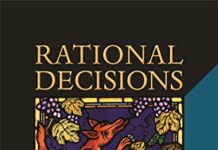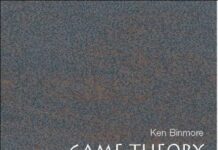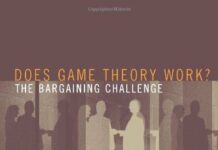
Ebook Info
- Published: 2007
- Number of pages: 639 pages
- Format: PDF
- File Size: 5.22 MB
- Authors: Ken Binmore
Description
Ken Binmore’s previous game theory textbook, Fun and Games (D.C. Heath, 1991), carved out a significant niche in the advanced undergraduate market; it was intellectually serious and more up-to-date than its competitors, but also accessibly written. Its central thesis was that game theory allows us to understand many kinds of interactions between people, a point that Binmore amply demonstrated through a rich range of examples and applications. This replacement for the now out-of-date 1991 textbook retains the entertaining examples, but changes the organization to match how game theory courses are actually taught, making Playing for Real a more versatile text that almost all possible course designs will find easier to use, with less jumping about than before. In addition, the problem sections, already used as a reference by many teachers, have become even more clever and varied, without becoming too technical. Playing for Real will sell into advanced undergraduate courses in gametheory, primarily those in economics, but also courses in the social sciences, and serve as a reference for economists.
User’s Reviews
Editorial Reviews: Review “Ken Binmore is an outstanding exponent of game theory. His many books are written in a delightfully fresh and engaging style, as is this one. Enjoy!”–Robert Aumann, Center for the Study of Rationality, The Hebrew University of Jerusalem, Nobel Laureate in Economic Sciences, 2005″Delightfully written and thoroughly revised, this long-awaited intellectual child of Ken Binmore’s Fun and Games retains the solid foundation of the original while expanding to cover an impressive array of new ideas. It stands out among game theory texts in explaining not only how to do game theory, but when and why to do it. It is the ideal place to learn game theory for the first time or to gain a fresh perspective on ideas that a career’s work have made familiar.” –Larry Samuelson, University of Wisconsin”One of the world’s leading game theorists explains the subject with sparkle and wit. He challenges the reader to think deeply about strategic rationality without becoming esoteric, and shows how the theory illuminates down-to-earth topics like gambling, auctions, business competition, and game show contests. A gem of a book written by a master.” –Peyton Young, Scott and Barbara Black Professor of Economics, Johns Hopkins University, and Professor of Economics, University of Oxford About the Author Ken Binmore is a mathematician-turned-economist who has devoted his life to the theory of games and its applications in economics, evolutionary biology, psychology, and moral philosophy. He is well known for his part in designing the telecom auction that raised $35 billion for the British taxpayer, but his major research contributions are to the theory of bargaining and its testing in the laboratory. He is a Fellow of the British Academy and of the American Academy of Arts and Sciences. He is the author of 12 books and some 90 research papers. He is Emeritus Professor of Economics at University College London.
Reviews from Amazon users which were colected at the time this book was published on the website:
⭐As the author of an excellent and innovative text on game theory (Game Theory Evolving, Princeton University Press), Herbert Gintis is far better qualified than this reviewer to provide a substantive evaluation of Ken Binmore’s new book; I encourage all prospective buyers to read Gintis’ comprehensive review very carefully.I would, however, like to offer some additional information for the specific audience of mathematicians and students of mathematics who are searching for an introductory text on game theory.Ken Binmore studied mathematics before becoming an economist; thus, one might expect that this book would provide rigorous proofs for all the results used, and mathematically inclined readers will be happy to hear that this is indeed the case. The intended readership is quite broad, however, and so Binmore ensured that it is possible for those who are inclined to skip the proofs to do so without suffering serious loss of continuity.In determining whether this text is appropriate for one’s specific study or instructional needs, one encounters two problems: (1) the table of contents is not available on Amazon, and (2) even when the chapter titles are made available, they are written in somewhat whimsical language that makes it difficult to determine precisely how the book is organized and precisely what it contains. In order to provide a bit of help in this area, I have provided the prospective buyer with both the chapter titles AND the section headings at the end of this review; I sincerely hope this helps in the process of determining whether this book represents a worthwhile investment, based on the specific needs of the buyer.One cautionary note for university instructors, especially instructors of mathematics; in the Preface, Binmore states that his book contains enough material for at least two courses in game theory. He writes”I have tried to make things easy for teachers who want to design a course based on selection of topics from the whole book by including marginal notes to facilitate skipping.”Thus, the instructor who is used to “possible course” charts, showing clear interdependence of chapters and identifying sections that might be skipped without penalty, will not find them in this book. The inclusion of this material would definitely have been a great kindness to university instructors; scouting one’s way through this 639-page text to find a realistic and effective one-semester course is not easy!Table of Contents1 Getting Locked In1.1 What is Game Theory?1.2 Toy Games1.3 The Prisoners’ Dilemma1.4 Private Provision of Public Goods1.5 Imperfect Competition1.6 Nash Equilibrium1.7 Collective Rationality1.8 Repeating the Prisoners’ Dilemma1.9 Which Equilibrium?1.10 Social Dilemmas1.11 Roundup2 Backing Up2.1 Where Next?2.2 Win-Or-Lose Games2.3 The Rules of the Game2.4 Pure Strategies2.5 Backward Induction2.6 Solving NIM2.7 Hex2.8 Chess2.9 Rational Play?2.10 Roundup3 Taking Chances3.1 Chance Moves3.2 Probability3.3 Conditional Probability3.4 Lotteries3.5 Expectation3.6 Values of Games with Chance Moves3.7 Waiting Games3.8 Parcheesi3.9 Roundup4 Accounting for Tastes4.1 Payoffs4.2 Revealed Preference4.3 Utility Functions4.4 Dicing with Death4.5 Making Risky Choices4.6 Utility Scales4.7 Dicing with Death Again4.8 When are People Consistent?4.9 Roundup5 Planning Ahead5.1 Strategic Forms5.2 Payoff Functions5.3 Matrices and Vectors5.4 Domination5.5 Credibility and Commitment5.6 Living in an Imperfect World5.7 Roundup6 Mixing Things Up6.1 Mixed Strategies6.2 Reaction Curves6.3 Interpreting Mixed Strategies6.4 Payoffs and Mixed Strategies6.5 Convexity6.6 Payoff Regions6.7 Roundup7 Fighting it Out7.1 Strictly Competitive Games7.2 Zero-Sum Games7.3 Minimax and Maximin7.4 Safety First7.5 Solving Zero-Sum Games7.6 Linear Programming7.7 Separating Hyperplanes7.8 Starships7.9 Roundup8 Keeping Your Balance8.1 Introduction8.2 Dueling Again8.3 When do Nash Equilibria Exist?8.4 Hexing Brouwer8.5 The Equilibrium Selection Problem8.6 Conventions8.7 Roundup9 Buying Cheap9.1 Economic Models9.2 Partial Derivatives9.3 Preferences in Commodity Spaces9.4 Trade9.5 Monopoly9.6 Perfect Competition9.7 Consumer Surplus9.8 Roundup10 Selling Dear10.1 Models of Imperfect Competition10.2 Cournot Models10.3 Stackelberg Models10.4 Bertrand Models10.5 Edgeworth Models10.6 Roundup11 Repeating Yourself11.1 Reciprocity11.2 Repeating a Zero-Sum Game11.3 Repeating the Prisoners’ Dilemma11.4 Infinite Repetitions11.5 Social Contract11.6 The Evolution of Cooperation11.7 Roundup12 Getting the Message12.1 Knowledge and Belief12.2 Dirty Faces12.3 Knowledge12.4 Possibility Sets12.5 Information Sets12.6 Common Knowledge12.7 Complete Information12.8 Agreeing to Disagree?12.9 Coordinated Action12.10 Roundup13 Keeping Up to Date13.1 Rationality13.2 Bayesian Updating13.3 Bayesian Rationality13.4 Getting the Model Right13.5 Scientific Induction?13.6 Constructing Priors13.7 Bayesian Rationality in Games13.8 Roundup14 Seeking Refinement14.1 Contemplating the Impossible14.2 Counterfactual Reasoning14.3 Backward and Imperfect14.4 Gang of Four14.5 Signaling Games14.6 Rationalizability14.7 Roundup15 Knowing What to Believe15.1 Complete Information15.2 Bluffing15.3 Incomplete Information15.4 Russian Roulette15.5 Duopoly with Incomplete Information15.6 Purification15.7 Incomplete Information about Rules15.8 Roundup16 Getting Together16.1 Bargaining16.2 Cooperative Game Theory16.3 Cooperative Payoff Regions16.4 Nash Bargaining Problems16.5 Supporting Hyperplanes16.6 Nash Bargaining Solution16.7 Collusion in a Cournot Duopoly16.8 Incomplete Information16.9 Other Bargaining Solutions16.10 Roundup17 Cutting a Deal17.1 Noncooperative Bargaining Models17.2 The Nash Program17.3 Commitment in Bargaining17.4 Nash Threat Games17.5 Bargaining Without Commitment17.6 Going Wrong17.7 Roundup18 Teaming Up18.1 Coalitions18.2 Coalitional Form18.3 Core18.4 Stable Sets18.5 Shapley Value18.6 Applying the Nash Program18.7 Roundup19 Just Playing?19.1 Ethics and Game Theory19.2 Do People Play Fair?19.3 Social Choice Paradoxes19.4 Welfare Functions19.5 Impersonal Comparison of Utility19.6 More Bargaining Solutions19.7 Political Philosophy19.8 Which Fairness Norm?19.9 Roundup20 Taking Charge20.1 Mechanism Design20.2 Principals and Agents20.3 Commitment and Contracting20.4 Revelation Principle20.5 Providing a Public Good20.6 Implementation Theory20.7 Roundup21 Going, Going, Gone!21.1 Telecom Auctions21.2 Types of Auctions21.3 Continuous Random Variables21.4 Shading Your Bid21.5 Designing Optimal Auctions21.6 Common-Value Auctions21.7 Multiunit Auctions21.8 The Chopstick Auction21.9 Roundup
⭐I recall reading the earlier edition of this book (even though the author insists that this book is too different to be a second edition) in a game theory class in college. This book seems to be an improvement to me, though my recollections of the first book are a bit poor. The author claims that more important topics are discussed in greater detail, while less important topics are omitted entirely. This seems like it might be true. The book also seems to be reorganized.All I care about is that it has everything I need for the project I’m working on. It also has a bunch of other stuff that I don’t care about. I recommend skipping parts of the book that are useless to you. Most of the exercises are interesting, and you can find the answers on the internet (not in the back of the back).There is one glaring problem with this book: there’s so many typos. I’m pretty sure the typos from the first edition are still in there. There’s one typo in particular that I recognize. There’s also some repetition in the book, but not enough to be annoying. What usually happens is that a topic will be given a brief overview and then used in one section but then explained in fair more detail in a later part of the book. This seems unnecessary to me, but there’s not so much of this.
⭐The book is in perfect condition with the exception of the fact that the binding was put on backwards. Thus, when you open the front cover, you’re looking at the back of the very last page in the book. The pages are thus, upside down and backwards.
⭐Read for school. Interesting read though
⭐Great book
⭐Good. (One. Two. Three. Four. Five. Six. Seven. Eight. Nine. Ten. Eleven. Twelve. Thirteen. Fourteen. Fifteen. Sixteen. Seventeen. Eighteen. Nineteen.)
⭐Excellent!
⭐The book is an excellent text on Game Theory. If you are into Game Theory, then this is a must have on your bookshelf. It covers Game Theory concepts in great detail and clarity. On the downside, the language used in the book, can, cat times, be vague and may require re-reading sections of the book to tease out what was being said. Nevertheless, the re-read is definitely worth it because you will find gems of wisdom bubbling to the surface.
⭐Hexとかチェスとか、まさに日常生活で見る「ゲーム」の分析を例に説明してくれます。数式は簡単だしexerciseは多いしで学部生でも独習できます。ただしBinmore先生独自の視点(哲学的!)でまとめられており、通常のゲーム論で見られるような目次(Subgame Perfect,Refinement,Auctionとか)はないので面食らうかも(だがそれがいい!)。ちなみにそういった概念は取り扱っているのでご安心を。重さとイギリス英語に耐性がある人は是非。アリスの絵が多く、可愛らしい。極力数式を使わずに例を多用した説明の仕方をしています。そこが○です。内容が簡単な本かといえばそうでもなくてなかなか手応えがありおもしろい本だと思います。かたくるしい本ではなくて読み物風です。目次を見ても内容が推測できません。疑問文や反語的な言いまわしが多く、見た事もないような単語が時々出て来ます。文脈を見失う事が多く、流し読みがしにくいです。辞書のお世話になる事が多くなります。そこが×。よって星4つです。
⭐
Keywords
Free Download Playing for Real: A Text on Game Theory in PDF format
Playing for Real: A Text on Game Theory PDF Free Download
Download Playing for Real: A Text on Game Theory 2007 PDF Free
Playing for Real: A Text on Game Theory 2007 PDF Free Download
Download Playing for Real: A Text on Game Theory PDF
Free Download Ebook Playing for Real: A Text on Game Theory



